Phase I. Intensive phase (volume reduction)
Phase II. Maintenance phase (volume stabilization)
Low-stretch bandages worn 24 h/24, for 1–3 weeks
Elastic garments, every day, from morning to evening
Manual lymph drainage
Low-stretch bandages overnight (3 or more per week)
Exercises
Exercises
Skin care
Skin care
Manual lymph drainage, if necessary
Low-Stretch Bandage
Each of the four CDT components has a different goal and those objectives are not of equal importance. Low-stretch bandage is the major element of CDT. It is able to achieve important and significant lymphedema-volume reduction. A low-stretch bandage is wrapped in multiple—2 to 4 (even 5 when lymphedema volume is huge)—layers after covering the affected limb with padding composed of foam and/or cotton batting (Figs. 19.1, 19.2, and 19.3). A low-stretch bandage is defined as having an elongation below 100 %, as previously described by Partsch et al. [6]. The bandage should be wrapped around the affected limb by a trained physiotherapist or nurse (depending on the various practices in different countries), applying pressure with the hand without pulling the band and squeezing the limb, which causes pain and makes it impossible for the patient to keep the bandage in place, especially during the night. Bandages are applied progressively, starting from the distal extremity (hand, foot, sometimes toe or finger) and gradually placed more proximally until reaching the axilla or groin (knee if lymphedema only concerns the lower leg). The low-stretch bandage exerts a low but not non-existent pressure that increases with muscular activity (exercise) that is recommended while wearing it. It may be kept in place for 24 h and reapplied every day or 48–72 h for the weekend. Bandaging may include finger/hand or toes/feet if they are affected by lymphedema (Figs. 19.4 and 19.5).
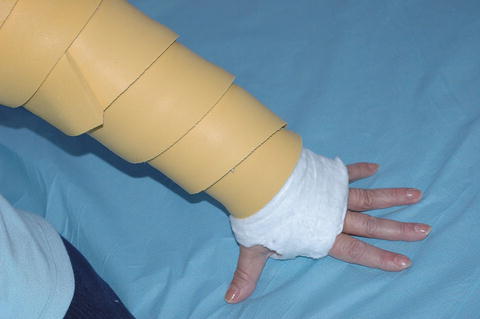
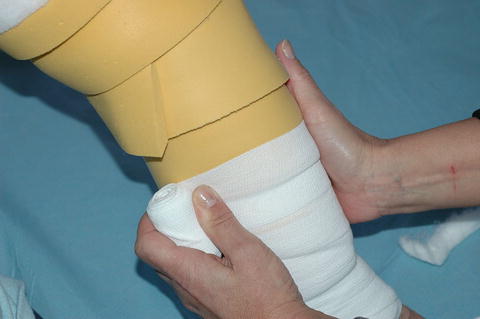
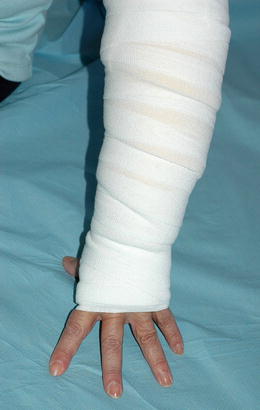
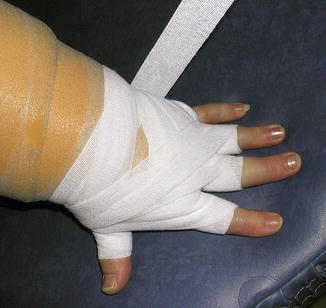
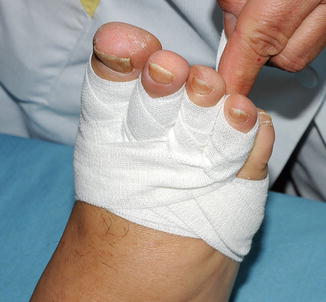

Fig. 19.1
Upper-limb lymphedema: bandage with foam

Fig. 19.2
Upper-limb lymphedema: foam padding partially covered with a first layer of low-stretch bandage

Fig. 19.3
Complete upper-limb low-stretch bandage for lymphedema

Fig. 19.4
Finger bandage for lymphedema

Fig. 19.5
Toe bandage with low-stretch bandage
Because bandages are the cornerstone of the first phase, the patient (self-bandaging technique) and/or family members are sometimes taught the technique during the intensive phase under the supervision of the physiotherapist or nurse. Each patient should be proposed several training sessions in validated specific patient-education programs to master the wrapping procedure and verify good understanding and implementation. At least three overnight bandages per week are recommended during the long-term maintenance phase. The aim of learning self-bandaging is to improve the patient’s autonomy to manage his/her own lymphedema.
During the maintenance phase, follow-up visits are scheduled at 6 and 12 months, and then annually to ensure lymphedema-volume stability and the patient’s motivation to pursue treatment. Workshops to reinforce the ability to pursue the self-bandaging technique are probably useful for patients having technical difficulties. Pertinently, because it must be maintained lifelong, lymphedema treatment is constraining.
After the intensive phase of treatment, most patients’ lymphedema volume tends to increase, often moderately, without reaching the pretreatment volume. The degree of adherence to regular low-stretch bandage strapping and wearing an elastic garment are the two predictors of whether or not the volume will increase [7]. Other types of bandages are currently not recommended for lymphedema management but some promising data are available on low-stretch cohesive bands [8].
Manual Lymph Drainage
MLD is a specific technique practiced by physiotherapists specialized in lymphatic-drainage techniques. The theoretical goal of MLD is to increase the lymphokinetic activity of normal lymphatics or stimulate the functional units of lymph vessels (lymphangion) to contract more frequently to channel lymph towards adjacent lymphatics. Several MLD technical variants (Casley-Smith, Vodder, Földi, Leduc) have been described, with or without node pumping, using more or less cutaneous pressure, and beginning on the proximal or distal side [9]. MLD usually lasts 30–45 min, or even longer for some authors. Classically, it begins by manual stimulation of the lymph nodes in adjacent drainage regions (neck, subclavicular, contralateral axilla, back, ipsilateral groin) and is followed by manual decongestion of the involved trunk, shoulder, arm, forearm and, if necessary, hand and fingers for the upper limb or back, abdomen, thigh, calf, and foot and, if necessary, toes. Several physiotherapists proposed not doing the first step of manual stimulation and retaining only manual decongestion; others suggest exerting greater pressure on the skin, especially when it is firm or hard.
MLD is recommended during the CDT intensive phase, just before applying the low-stretch bandage, and procures an additive effect, particularly for patients with moderate lymphedema [10]. MLD is not considered a stand-alone treatment for lymphedema to reduce volume but is advocated for breast, thoracic, mons pubic, face, or neck lymphedema, as these zones are difficult to compress or inaccessible to compression with bandages or an elastic garment, or in a palliative care context that is inconducive to compression [9, 11].
MLD is not consistently recommended during the maintenance phase. However, patients may learn self-lymphatic drainage (SLD), also called modified lymphatic drainage, to be performed while in a decubitus position. SLD is easy to do for breast, upper limb, or mons pubic lymphedema but more difficult for the lower limb. The patient must be highly motivated to learn and practice self-drainage.
In any case, MLD also assures regular follow-up by the physiotherapist and may help encourage some patients to find the necessary motivation to pursue and comply with long-term treatment (bandage, elastic garment). Notably, MLD may also improve their quality of life by reducing psychosocial and lymphedema-related symptoms [9].
Exercises
Exercises are considered another major component of CDT. Most of the proposed exercises concern upper-limb lymphedema occurring after breast-cancer treatment; much fewer deal with primary or secondary lower-limb lymphedema. Different types of exercises have been devised: against/without resistance, isometric, aerobic, including the lymphedematous limb, with repetitive, progressive, and therapist-guided movements. Various types of soft and remedial exercises are used, always associated with posture correction, abdominal breathing, including neck (stretches), shoulder (shrugs, rotations, stretches), arm (isometric biceps curl), elbow (circles), forearm, wrist (rotations), and fingers (opening/closing) [2]. During the CDT intensive phase, ideally with the short-stretch bandage or elastic garment in place, these exercises are intended to facilitate lymph resorption into remaining functional lymph channels. However, muscular activity may more difficult while wearing an elastic garment (recommended) that nonetheless appears essential in this situation [12, 13]. During the maintenance phase, patients are encouraged to continue regular daily exercises at home.
Speaking more generally, physical activity is always recommended for lymphedema patients, whose disease and/or comorbidities do not impose medical restrictions, especially when the upper limb is affected and even outside the CDT setting. Importantly, exercises, even intensive, such as weight lifting, Dragon Boat racing or pole walking, do not trigger or worsen lymphedema, and might even prevent it [14–16]. Physical activity greatly improves the quality of life after breast-cancer treatment and reduces the risk of breast-cancer recurrence and mortality due to it [17]. In conclusion, exercising is strongly recommended for lymphedema patients but the movements should be progressive in intensity and repeated, under the supervision of a trained therapist, and ideally done while wearing an elastic garment and guided by the patient’s sensations.
Skin and Nail Care
Meticulous skin and nail care is mandatory for patients with lymphedema. Patients with limb lymphedema are confronted with various cutaneous complications, most of which can represent a site of entry for infections, particularly cellulitis (erysipelas). Notably, lower-limb lymphedema increases the risk of cellulitis 70-fold, in comparison to a non-lymphedematous limb [18]. Moreover, skin care is also essential to prevent worsening of the condition and infections. Cutaneous disorders predominate in the lower limb and include different types of lesions, whose treatments are specific:
Nail deformation: nail plates are shortened and hypercurved, with possible raised toenails, with the risk of ingrown toenails (pedicure, eventually nail surgery);
Stay updated, free articles. Join our Telegram channel

Full access? Get Clinical Tree







